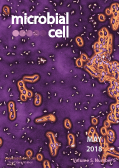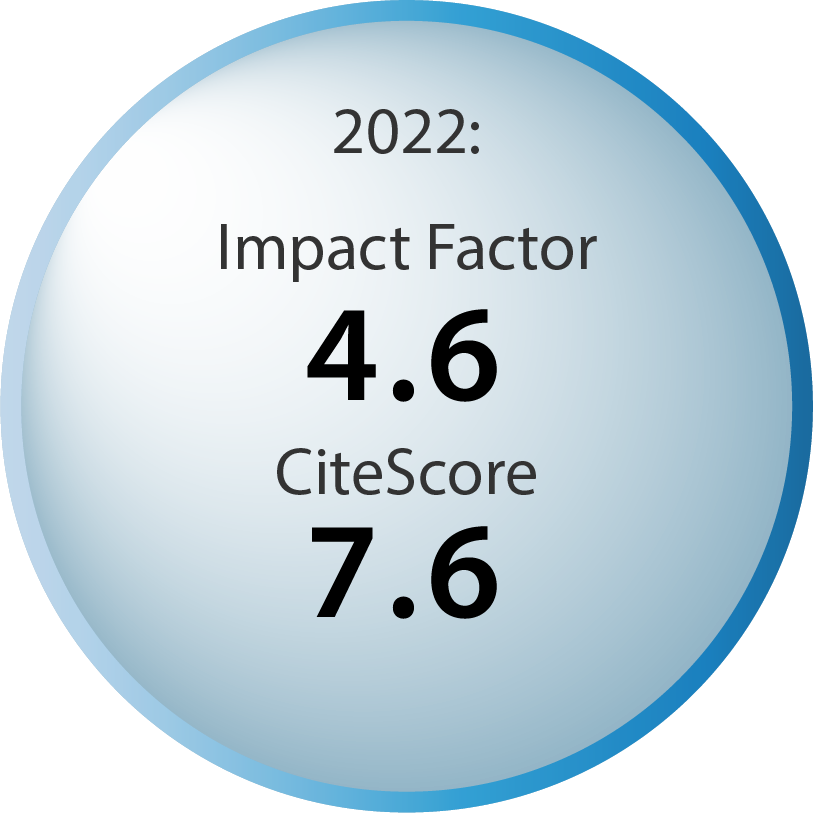Table of contents
Volume 5, Issue 5, pp. 215 - 261, May 2018
Cover: Colorized microscopy image of a liquid co-culture of Candida albicans and Escherichia coli (image by Peter Belenky, Brown University, Providence, RI, USA); image modified by MIC. The cover is published under the Creative Commons Attribution (CC BY) license.
Enlarge issue cover
Microbial wars: competition in ecological niches and within the microbiome
Maria A. Bauer, Katharina Kainz, Didac Carmona-Gutierrez and Frank Madeo
Editorial |
page 215-219 | 10.15698/mic2018.05.628 | Full text | PDF |
Abstract
Many microbial communities live in highly competitive surroundings, in which the fight for resources determines their survival and genetic persistence. Humans live in a close relationship with microbial communities, which includes the health- and disease-determining interactions with our microbiome. Accordingly, the understanding of microbial competitive activities are essential at physiological and pathophysiological levels. Here we provide a brief overview on microbial competition and discuss some of its roles and consequences that directly affect humans.
Decreasing cytosolic translation is beneficial to yeast and human Tafazzin-deficient cells
Maxence de Taffin de Tilques, Jean-Paul Lasserre, François Godard, Elodie Sardin, Marine Bouhier, Marina Le Guedard, Roza Kucharczyk, Patrice X. Petit, Eric Testet, Jean-Paul di Rago, Déborah Tribouillard-Tanvier
Research Articles |
page 220-232 | 10.15698/mic2018.05.629 | Full text | PDF |
Abstract
Cardiolipin (CL) optimizes diverse mitochondrial processes, including oxidative phosphorylation (OXPHOS). To function properly, CL needs to be unsaturated, which requires the acyltransferase Tafazzin (TAZ). Loss-of-function mutations in the TAZ gene are responsible for the Barth syndrome (BTHS), a rare X-linked cardiomyopathy, presumably because of a diminished OXPHOS capacity. Herein we show that a partial inhibition of cytosolic protein synthesis, either chemically with the use of cycloheximide or by specific genetic mutations, fully restores biogenesis and the activity of the oxidative phosphorylation system in a yeast BTHS model (taz1Δ). Interestingly, the defaults in CL were not suppressed, indicating that they are not primarily responsible for the OXPHOS deficiency in taz1Δ yeast. Low concentrations of cycloheximide in the picomolar range were beneficial to TAZ-deficient HeLa cells, as evidenced by the recovery of a good proliferative capacity. These findings reveal that a diminished capacity of CL remodeling deficient cells to preserve protein homeostasis is likely an important factor contributing to the pathogenesis of BTHS. This in turn, identifies cytosolic translation as a potential therapeutic target for the treatment of this disease.
Spontaneous mutations in CYC8 and MIG1 suppress the short chronological lifespan of budding yeast lacking SNF1/AMPK
Nazif Maqani, Ryan D. Fine, Mehreen Shahid, Mingguang Li, Elisa Enriquez-Hesles and Jeffrey S. Smith
Research Articles |
page 233-248 | 10.15698/mic2018.05.630 | Full text | PDF |
Abstract
Chronologically aging yeast cells are prone to adaptive regrowth, whereby mutants with a survival advantage spontaneously appear and re-enter the cell cycle in stationary phase cultures. Adaptive regrowth is especially noticeable with short-lived strains, including those defective for SNF1, the homolog of mammalian AMP-activated protein kinase (AMPK). SNF1 becomes active in response to multiple environmental stresses that occur in chronologically aging cells, including glucose depletion and oxidative stress. SNF1 is also required for the extension of chronological lifespan (CLS) by caloric restriction (CR) as defined as limiting glucose at the time of culture inoculation. To identify specific downstream SNF1 targets responsible for CLS extension during CR, we screened for adaptive regrowth mutants that restore chronological longevity to a short-lived snf1∆ parental strain. Whole genome sequencing of the adapted mutants revealed missense mutations in TPR motifs 9 and 10 of the transcriptional co-repressor Cyc8 that specifically mediate repression through the transcriptional repressor Mig1. Another mutation occurred in MIG1 itself, thus implicating the activation of Mig1-repressed genes as a key function of SNF1 in maintaining CLS. Consistent with this conclusion, the cyc8 TPR mutations partially restored growth on alternative carbon sources and significantly extended CLS compared to the snf1∆ parent. Furthermore, cyc8 TPR mutations reactivated multiple Mig1-repressed genes, including the transcription factor gene CAT8, which is responsible for activating genes of the glyoxylate and gluconeogenesis pathways. Deleting CAT8 completely blocked CLS extension by the cyc8 TPR mutations on CLS, identifying these pathways as key Snf1-regulated CLS determinants.
Microbial competition between Escherichia coli and Candida albicans reveals a soluble fungicidal factor
Damien J. Cabral, Swathi Penumutchu, Colby Norris, Jose Ruben Morones-Ramirez and Peter Belenky
Research Reports |
page 249-255 | 10.15698/mic2018.05.631 | Full text | PDF |
Abstract
Localized and systemic fungal infections caused by Candida albicans can lead to significant mortality and morbidity. However, severe C. albicans infections are relatively rare, occurring mostly in the very young, the very old, and immunocompromised individuals. The fact that these infections are rare is interesting because as much as 80 percent of the population is asymptomatically colonized with C. albicans. It is thought that members of the human microbiota and the immune system work in concert to reduce C. albicans overgrowth through competition and modification of the growth environment. Here, we report that Escherichia coli (strain MG1655) outcompetes and kills C. albicans (strain SC5314) in vitro. We find that E. coli produces a soluble factor that kills C. albicans in a magnesium-dependent fashion such that depletion of available magnesium is essential for toxicity.
A novel mechanism for regulation of the type I IFN response by herpesvirus deconjugases
Soham Gupta, Päivi Ylä-Anttila, Maria G. Masucci
Microreviews |
page 259-261 | 10.15698/mic2018.05.633 | Full text | PDF |
Abstract
Upon infection, viral nucleic acids are recognized by germline-encoded pattern-recognition receptors (PRRs), and cytosolic retinoic acid-inducible gene I (RIG-I)-like helicases (RLHs) that initiate signaling pathways resulting in the production of type I IFN and pro-inflammatory cytokines. Binding of RIG-I to viral nucleic acids triggers the formation of the RIG-I signalosome where RIG-I is ubiquitinated by the TRIM25 ligase and, with the help of 14-3-3 scaffolds, further translocated to mitochondrial anti-viral signalling proteins (MAVS). Subsequent ubiquitination-mediated events trigger transcriptional activation of the effectors of innate immunity. We have found a new mechanism by which herpesviruses interfere with this signalling pathway to favour the establishment of latency and promote virus replication. The cysteine protease encoded in the conserved N-terminal domain of the herpesvirus large tegument protein binds to 14-3-3 proteins and forms a tri-molecular complex with TRIM25, promoting the activation and autoubiquitination of the ligase. RIG-I is recruited to the complex but its ubiquitination is drastically reduced, which effectively inactivates downstream signalling and blocks the type I IFN response.
Metabolic disharmony and sibling conflict mediated by T6SS
Vera Troselj and Daniel Wall
Microreviews |
page 256-258 | 10.15698/mic2018.05.632 | Full text | PDF |
Abstract
Bacteria in nature live in taxonomically complex communities where multitude of species and strains inhabit the same niches and compete for limited resources and space. Surviving in these competitive environments requires mechanisms to recognize and associate with kin and to discriminate against non-kin to increase reproductive success among close relatives. Some of the mechanisms bacteria use to address genetic differences are surface receptors, diffusible signals (e.g. quorum sensing) and toxin-immunity systems (e.g. type VI secretion system (T6SS)). Another way individuals vary within bacterial populations is their physiological states. This means that among clonal cells there is cell-to-cell variability in cells’ proteome, growth rates, age and cell damage loads caused by stochastic differences in gene expression/metabolism and variations in microenvironmental stimuli. While physiological heterogeneity benefits some bacteria by allowing populations to bet-hedge their survival odds in changing environments by expressing different phenotypes, it can also be harmful in cases where fitness depends on coordinated behaviors and synchronized actions by many cells; a function of particular importance to social bacteria. Myxococcus xanthus is a non-pathogenic soil bacterium known for its complex social and coordinated behaviors such as swarming, predation and formation of spore-filled fruiting bodies. These behaviors depend on M. xanthus ability to synchronize the actions of many cells within a population. Considering the collective nature of M. xanthus, we asked how do physiological differences affect cell-cell interactions in this species. To address this question, we investigated the interactions between two genetically related but physiologically distinct populations. We found that M. xanthus uses T6SS to eliminate less fit cells from their population and identified toxic effector and cognate immunity protein (TsxEI) that mediates this sibling antagonism.










